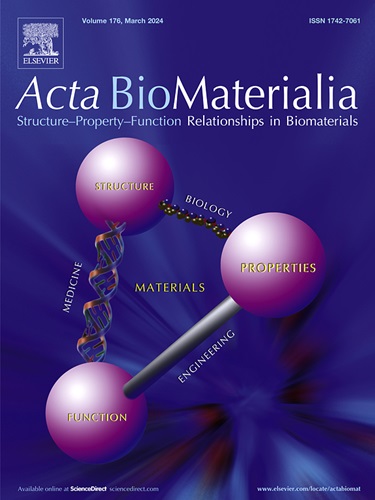通过润滑微球促进界面愈合的PI3K/AKT/mTOR/MMP-13通路下调
IF 9.4
1区 医学
Q1 ENGINEERING, BIOMEDICAL
引用次数: 0
摘要
界面摩擦阻碍组织愈合并刺激界面细胞产生基质金属蛋白酶(MMPs);然而,基质降解和纤维疤痕形成的确切机制尚不清楚。本研究涉及界面润滑微球的开发,该微球可抑制细胞中PI3K/AKT/mTOR信号通路。这种抑制显著降低了MMP-13的表达,增加了COL-1的产生,从而促进了界面的修复和再生。体外实验表明,界面摩擦激活了PI3K/AKT/mTOR/MMP-13信号通路,而使用界面润滑微球减少了78%的摩擦,通过途径抑制导致MMP-13表达降低三倍。动物实验表明,界面润滑微球的应用减少了肌腱-骨界面的摩擦,减轻了mmp -13介导的基质降解,有效减少了纤维疤痕的形成(α-SMA表达减少),从而促进大鼠ACLR手术后界面愈合。因此,本研究表明,界面摩擦可以触发细胞中PI3K/AKT/mTOR信号通路,导致MMP-13表达增加、基质降解和纤维瘢痕形成。使用界面润滑微球可以通过抑制这一途径来增强界面愈合,为改善界面愈合和减少纤维疤痕形成提供了策略。意义声明:界面愈合在肌腱-骨手术后起着至关重要的作用,但它经常受到界面摩擦和疤痕形成等挑战的阻碍。在这项研究中,我们提出了一种结合使用润滑微球和抗基质降解药物来增强界面愈合的方法。我们制备了新型润滑微球,具有出色的生物相容性和可降解性;这些微球作为肌腱-骨界面的润滑剂,促进强力霉素的递送,以减少过量的基质金属蛋白酶(MMP)分泌。实验结果表明,该方法能促进大鼠肌腱-骨界面愈合,导致骨形成增加,组织学评分高于对照组。这项研究代表了将润滑和抗基质降解结合在界面愈合中的初步努力,可能为界面摩擦和纤维疤痕愈合之间的机制提供新的见解,同时通过减少界面摩擦来促进界面愈合。本文章由计算机程序翻译,如有差异,请以英文原文为准。

Downregulation of the PI3K/AKT/mTOR/MMP-13 pathway for promoting interface healing via lubricating microspheres
Interface friction impedes tissue healing and stimulates interface cells to produce matrix metalloproteinases (MMPs); however, the precise mechanisms underlying matrix degradation, and the formation of fibrous scars remain unclear. This research involved the development of interface lubricating microspheres that inhibit the PI3K/AKT/mTOR signaling pathway in tenocytes. This inhibition significantly decreased MMP-13 expression and increased COL-1 production, thereby facilitating interface repair and regeneration. In vitro experiments demonstrated that interface friction activates the PI3K/AKT/mTOR/MMP-13 signaling pathway, while the use of interface lubricating microspheres reduced friction by 78 %, resulting in a threefold decrease in MMP-13 expression through pathway inhibition. Animal studies showed that the application of interface lubricating microspheres reduced friction at the tendon-bone interface, mitigating MMP-13-mediated matrix degradation and effectively reducing fibrous scar formation (as evidenced by decreased α-SMA expression), thus promoting interface healing following ACLR surgery in rats. Consequently, this study suggests that interface friction can trigger the PI3K/AKT/mTOR signaling pathway in tenocytes, leading to increased MMP-13 expression, matrix degradation, and fibrous scar formation. The use of interface lubricating microspheres can enhance interface healing by inhibiting this pathway, offering strategies for improving interface healing and minimizing fibrous scar formation.
Statement of significance
Interface healing plays a crucial role following tendon-bone surgeries, yet it is often hindered by challenges such as interface friction and scar formation. In this study, we propose a combined approach in which lubricating microspheres and an anti-matrix degradation drug are used to enhance interface healing. We fabricated novel lubricating microspheres that exhibit outstanding biocompatibility and degradability; these microspheres serve as lubricants for the tendon-bone interface and facilitate the delivery of doxycycline to reduce excessive matrix metalloproteinase (MMP) secretion. The experimental results demonstrated that this method could enhance tendon-bone interface healing in rats, resulting in increased bone formation and higher histological scores than those of the control group. This study represents a preliminary effort to integrate lubrication and anti-matrix degradation in interface healing, potentially offering new insights into the mechanism between interface friction and fibrous scar healing, while promoting interface healing by reducing interfacial friction.
求助全文
通过发布文献求助,成功后即可免费获取论文全文。
去求助
来源期刊

Acta Biomaterialia
工程技术-材料科学:生物材料
CiteScore
16.80
自引率
3.10%
发文量
776
审稿时长
30 days
期刊介绍:
Acta Biomaterialia is a monthly peer-reviewed scientific journal published by Elsevier. The journal was established in January 2005. The editor-in-chief is W.R. Wagner (University of Pittsburgh). The journal covers research in biomaterials science, including the interrelationship of biomaterial structure and function from macroscale to nanoscale. Topical coverage includes biomedical and biocompatible materials.
 求助内容:
求助内容: 应助结果提醒方式:
应助结果提醒方式:


